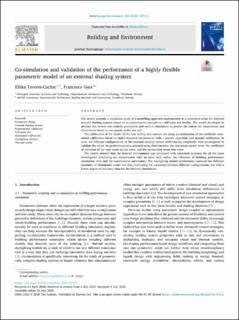| dc.contributor.author | Taveres-Cachat, Ellika | |
| dc.contributor.author | Goia, Francesco | |
| dc.date.accessioned | 2020-08-24T08:42:35Z | |
| dc.date.available | 2020-08-24T08:42:35Z | |
| dc.date.created | 2020-08-14T11:29:50Z | |
| dc.date.issued | 2020 | |
| dc.identifier.citation | Building and Environment. 2020, 182 . | en_US |
| dc.identifier.issn | 0360-1323 | |
| dc.identifier.uri | https://hdl.handle.net/11250/2673530 | |
| dc.description.abstract | The article presents a validation study of a modelling approach implemented in a numerical script for external
louvred shading systems based on an experimental analysis in a full-scale test facility. The model developed to
abstract the system was entirely parametric and used co-simulation to predict the indoor air temperature and
illuminance levels in two points of the test cell.
The calibration of the model of the test facility was carried out using a combination of two methods: automated calibration based on multi-objective optimization with a genetic algorithm and manual calibration. In
total, six different configurations of the external shading system with varying complexity were investigated to
validate the script. Its performance was assessed using three metrics: the root mean square error, the coefficient
of variation of the root mean square error, and the normalized mean bias error.
The results showed that the thermal environment was simulated with consistent accuracy for all the cases
investigated, predicting air temperatures with an error well within the tolerance of building performance
simulation tools and the experimental uncertainty. The daylighting model satisfactorily captured the different
dynamics of illuminance peaks and dips, replicating the variations between different configurations, but with a
lower degree of accuracy than for the thermal simulations. | en_US |
| dc.language.iso | eng | en_US |
| dc.publisher | Elsevier | en_US |
| dc.rights | Navngivelse 4.0 Internasjonal | * |
| dc.rights.uri | http://creativecommons.org/licenses/by/4.0/deed.no | * |
| dc.title | Co-simulation and validation of the performance of a highly flexible parametric model of an external shading system | en_US |
| dc.type | Peer reviewed | en_US |
| dc.type | Journal article | en_US |
| dc.description.version | publishedVersion | en_US |
| dc.source.pagenumber | 15 | en_US |
| dc.source.volume | 182 | en_US |
| dc.source.journal | Building and Environment | en_US |
| dc.identifier.doi | 10.1016/j.buildenv.2020.107111 | |
| dc.identifier.cristin | 1823324 | |
| dc.relation.project | Norges forskningsråd: 255252 | en_US |
| dc.description.localcode | Available online 24 July 2020 0360-1323/© 2020 The Authors. Published by Elsevier Ltd. This is an open access article under the CC BY license (http://creativecommons.org/licenses/by/4.0/) | en_US |
| cristin.ispublished | true | |
| cristin.fulltext | original | |
| cristin.qualitycode | 2 | |

